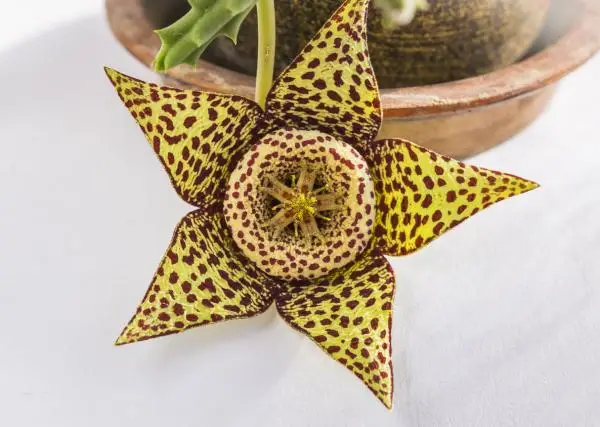The Stapelia plant is a difficult one to forget. Either because of its large and particular flower, which Stranger Things fans will recognize at first glance, or because of the fetid aroma that it gives off, the Stapelia leaves an impression that, although impressive, is not for all audiences.
Perhaps it is precise because of that eccentric touch that many choose to include it in their collections or gardens, and it is that it is a unique plant. If you want to learn more about what type of plant Stapelia is, join us in this article where you will find a guide to caring for Stapelia.
Characteristics of the Stapelia
Let’s start by knowing a little better the main characteristics of the Stapelia plant:
- It is known as lizard flower, dragon flower, stapelia, starfish plant and even, among the most addicted circles to the series, demogorgon plant .
- It is a whole genus of plants of the Apocynaceae family, with about 50 species, all of them succulent plants and originating in South Africa.
- Among the different types of Stapelia we find some of the best known, such as Stapelia Variegata , Stapelia Gigantea , Stapelia Flavopurpurea and Stapelia Grandiflora , the most common in gardening.
- They are slow-growing plants, well known for their showy flowers, which can reach diameters of up to 40 cm in larger species. The Stapelia flower stands out not only for its striking appearance but, as we have mentioned, for the fetid aroma that we will recognize if we get close to smelling it. This responds to the need to attract its pollinators, which are none other than blue flies. There is a variety, however, the Stapelia Flavopurpurea , whose smell is not unpleasant, reminiscent of beeswax.
- These flowers are very hairy and glossy in texture, with colors and patterns that vary greatly depending on the species.
- And when does the Stapelia bloom ? The showy and fragrant flowers appear between summer and autumn, so in the cold months it is possible to move the plant indoors without danger of perfuming the home with an unpleasant odor.
- Its succulent stems have serrated margins, with four well marked sides, and which grow in the shape of claws, without apparent order or concert on many occasions. They are largely part of its exotic appeal.

Location and weather for La Stapelia
Like many succulent plants, Stapelia is not particularly fussy about its care. They are adapted to temperatures between warm and temperate and dry climates, with an optimum temperature of about 25 ºC in spring and summer, although from 20 ºC the plant is already well.
In the cold months, we should never expose it below 10 ºC, since lower temperatures do considerable damage to it and could even kill it. Taking this into account, of course, that it survives the frosts is totally ruled out.
Regarding light, the plant needs at least a semi-shade exposure, although in environments without a very strong sun it will appreciate direct exposure. If you see that the stems of your Stapelia turn reddish or purple, it means that the plant is stressed from receiving too intense sun, and you will need to put it a little more undercover.

Irrigation of the Stapelia
Despite being crass, the Stapelia is not a cactus and needs more abundant watering than these. Of course, when it comes to knowing how to care for Stapelia, it is vital to take into account that, like most plants of its characteristics, it does not tolerate flooding at all. Water it frequently but with little quantity, ensuring that the substrate never dries completely, but always taking care to avoid waterlogging the soil or the pot. If this happens, it is very likely that the roots of your Stapelia will be affected by rot. At this point, it is always preferable to fall short than to overdo it. If you see that the stems of your plant begin to wrinkle and lose volume, slightly increase the irrigation doses until they return to their normal appearance.
Substrate for the Stapelia plant
Here the plant is not demanding at all, being one of the main reasons why it is so easy to grow. The only important thing that you have to maintain is that the substrate or soil offers the best possible drainage, to avoid accumulations of water that would damage the plant.
Any light, the sandy mixture will do, to which you can add vermiculite and perlite to improve its properties. You can also place a bed of thick pebbles at the base of the pot, precisely to prevent the roots from being in direct contact with unwanted moisture accumulations in the dish.
Vegetative period
This is one of those plants that appreciate spending a few winter months at a lower temperature to enter a state of winter rest. When winter arrives, place it in an area around 15 ºC and reduce the frequency of watering significantly so that the plant comes to rest, so that when spring arrives it will reactivate with more energy.

